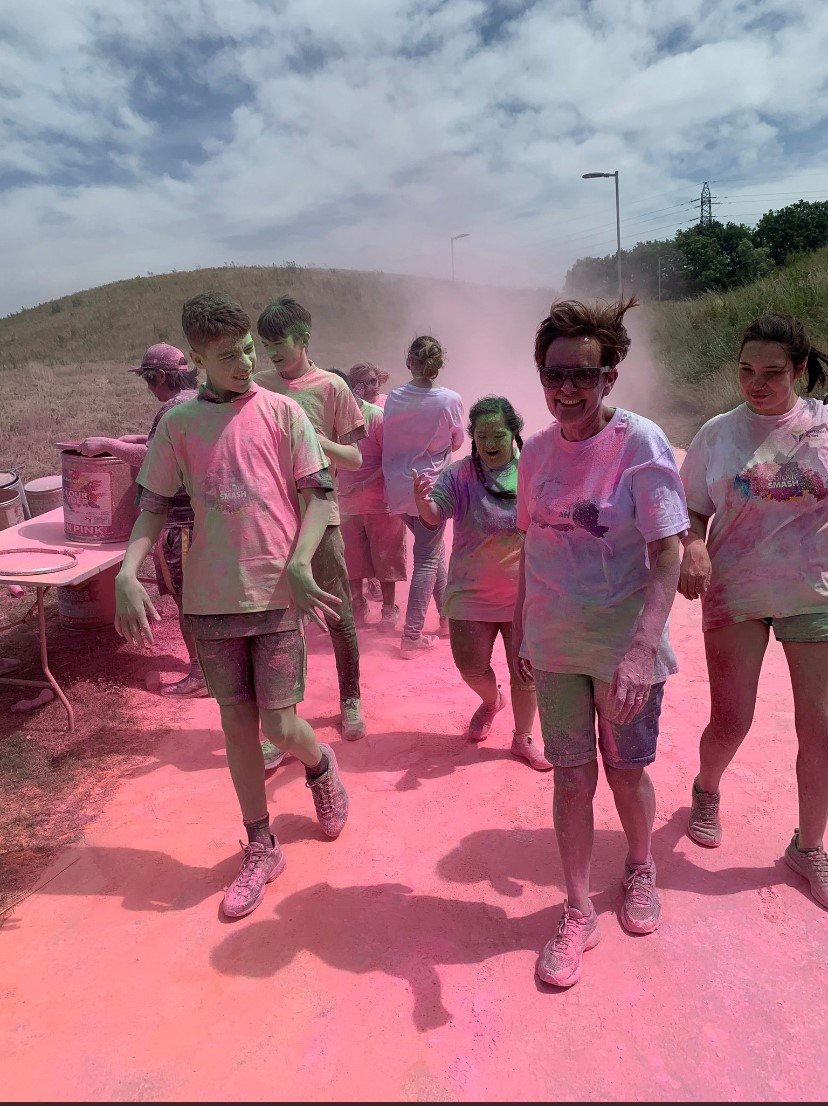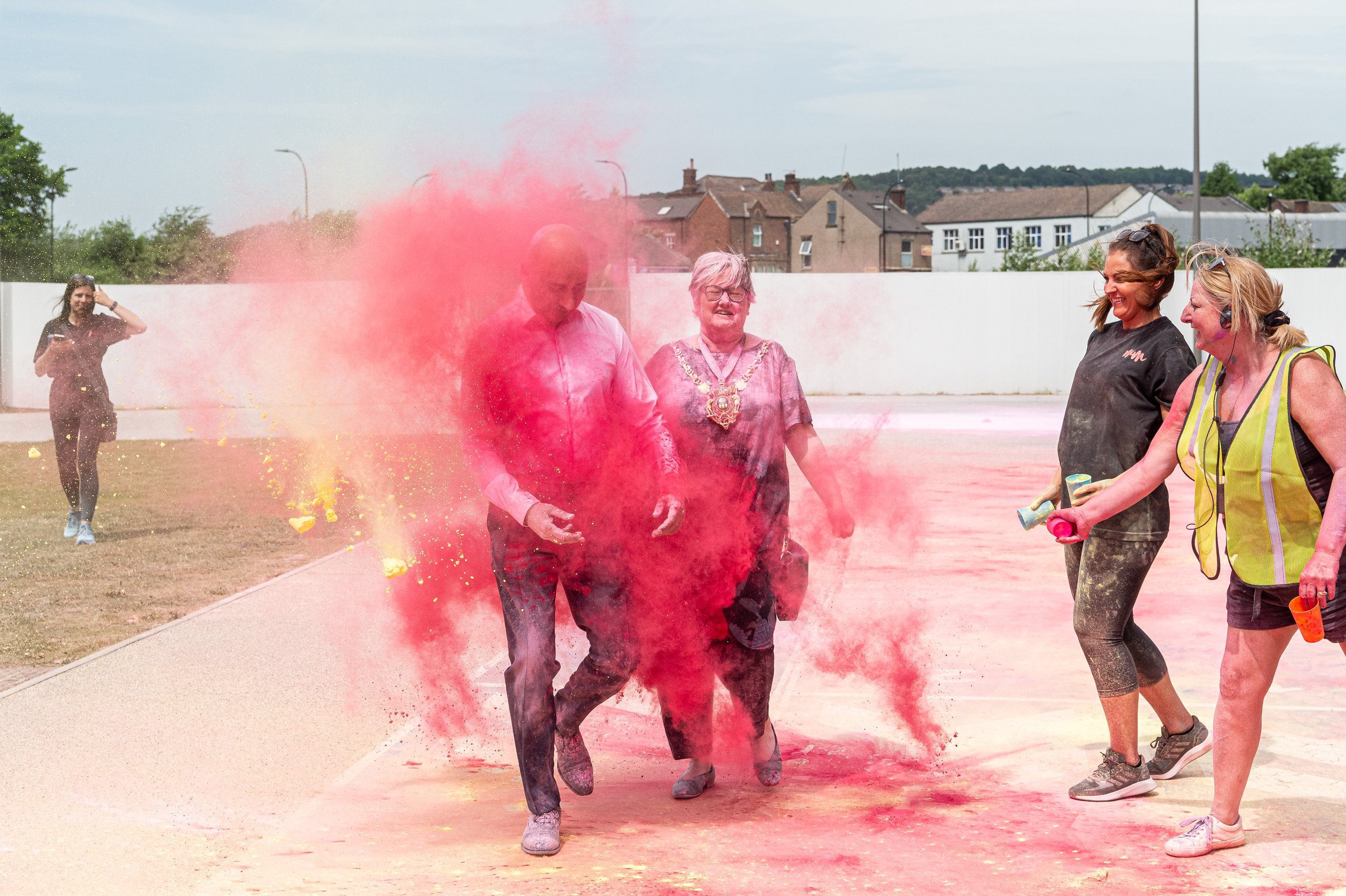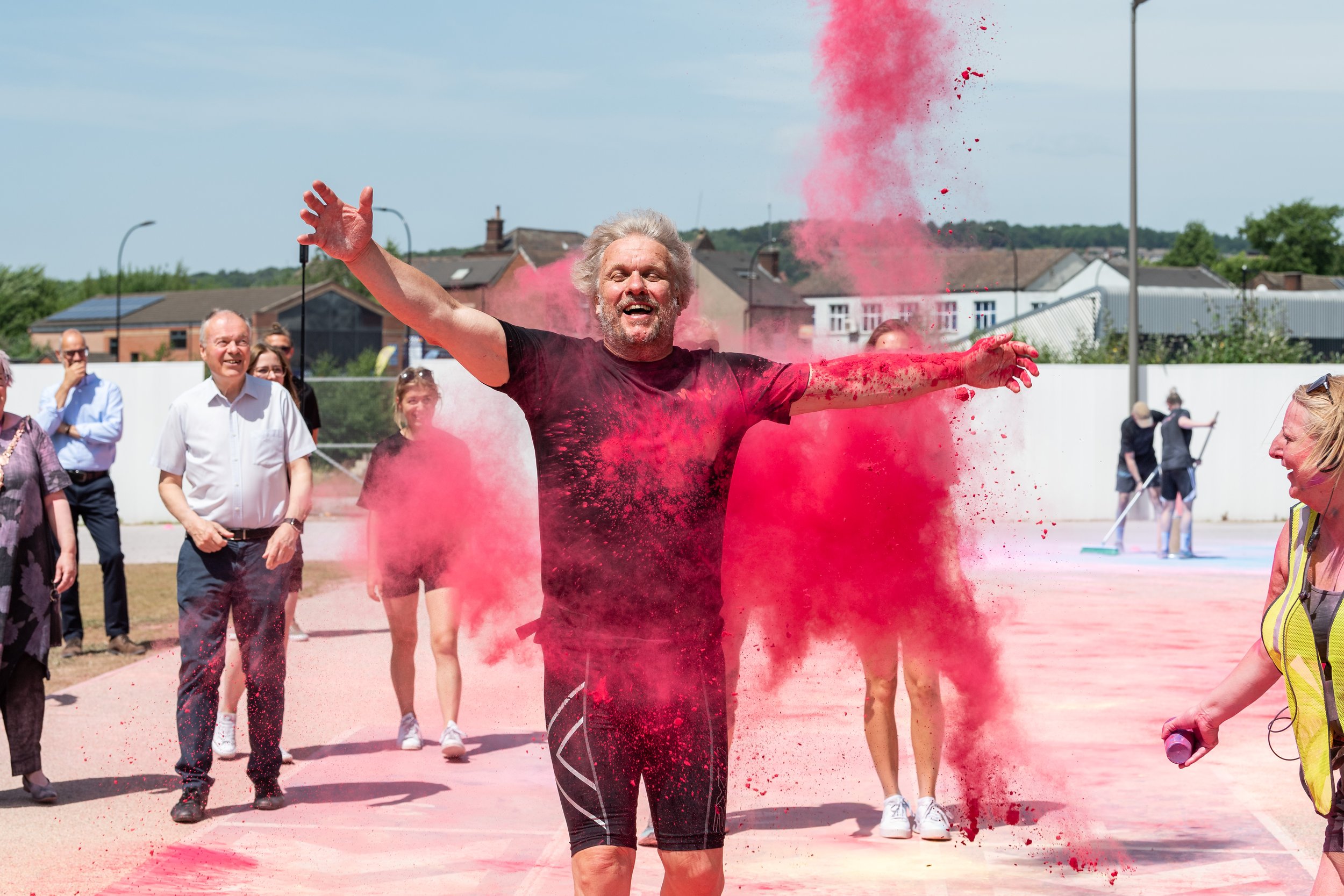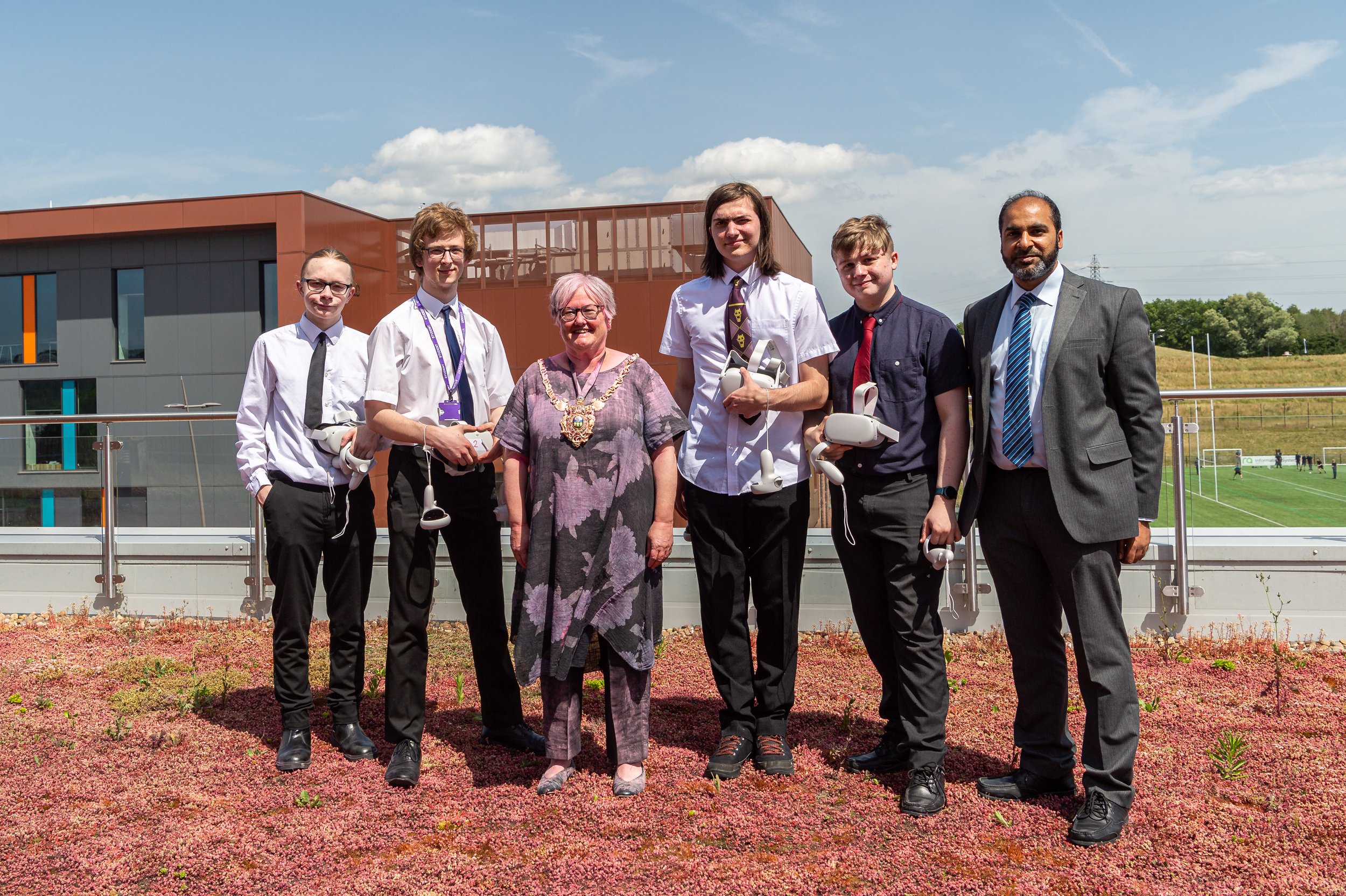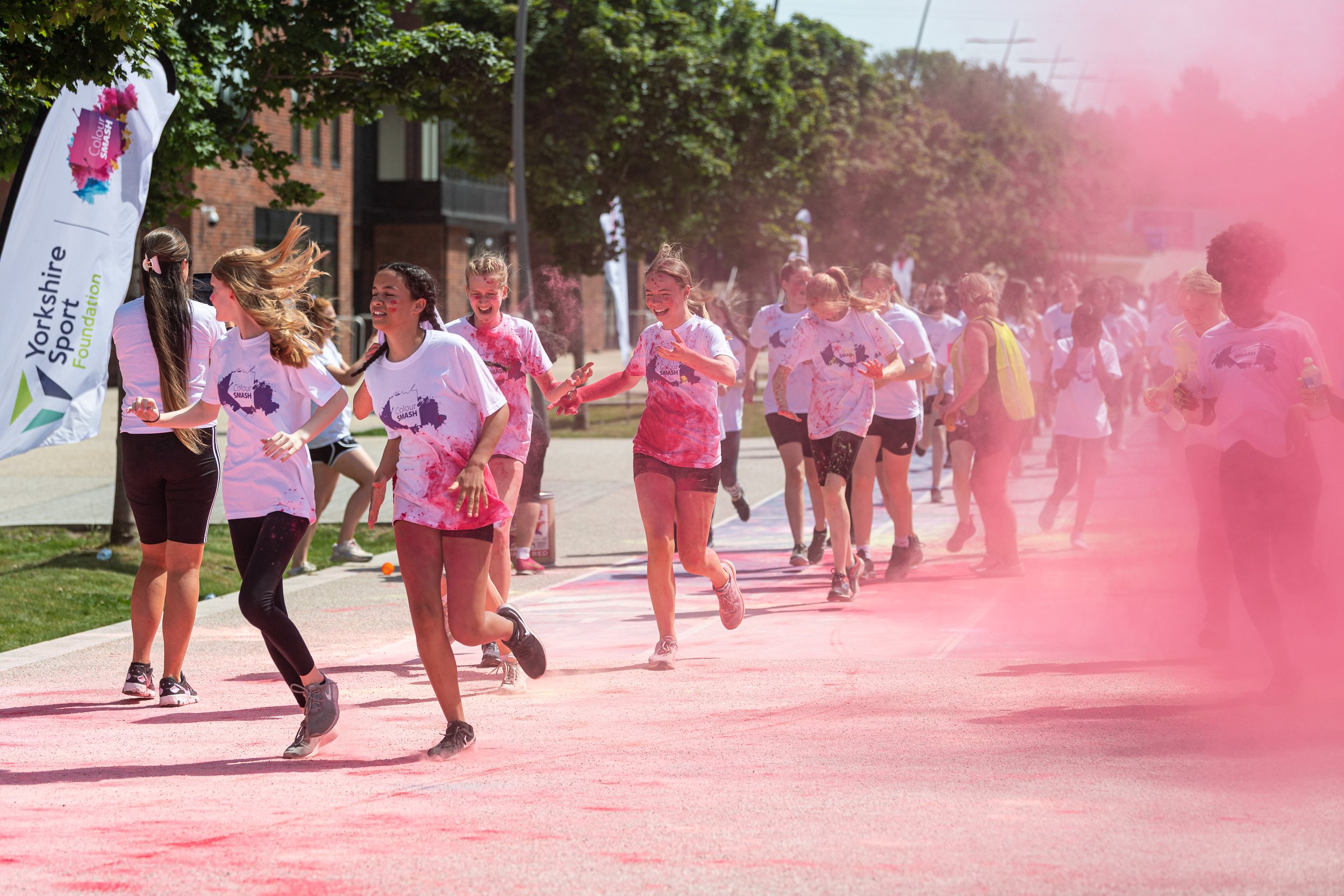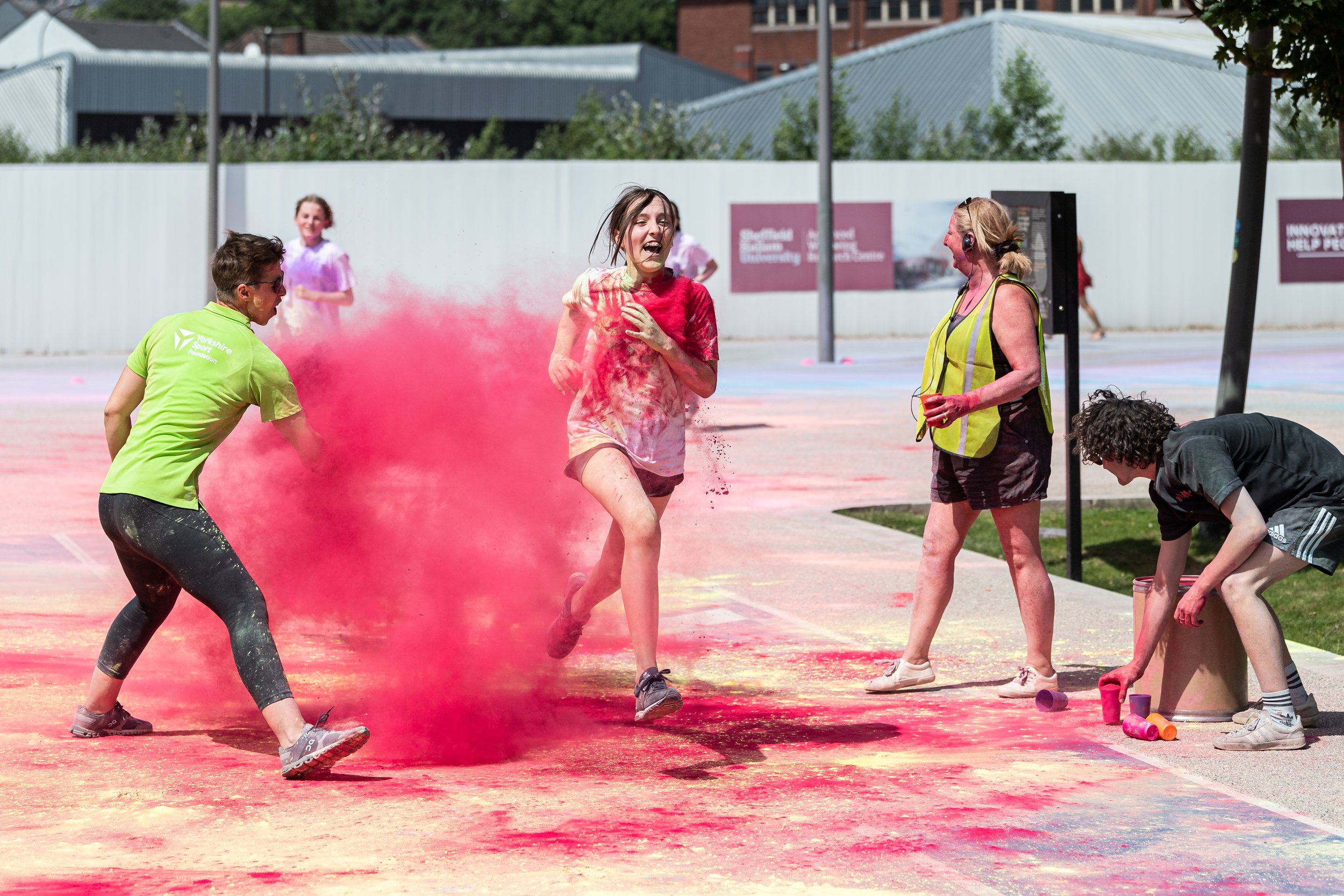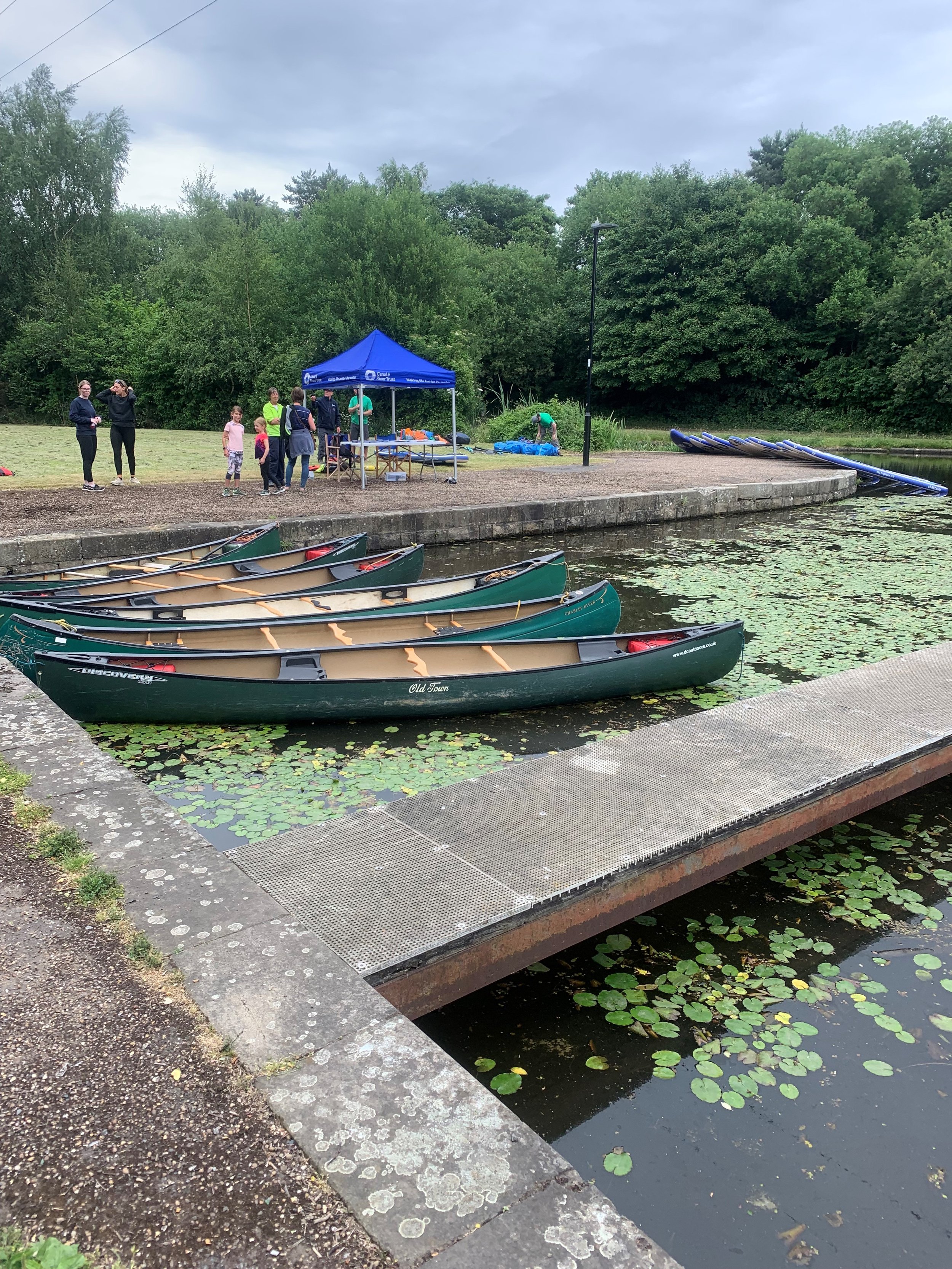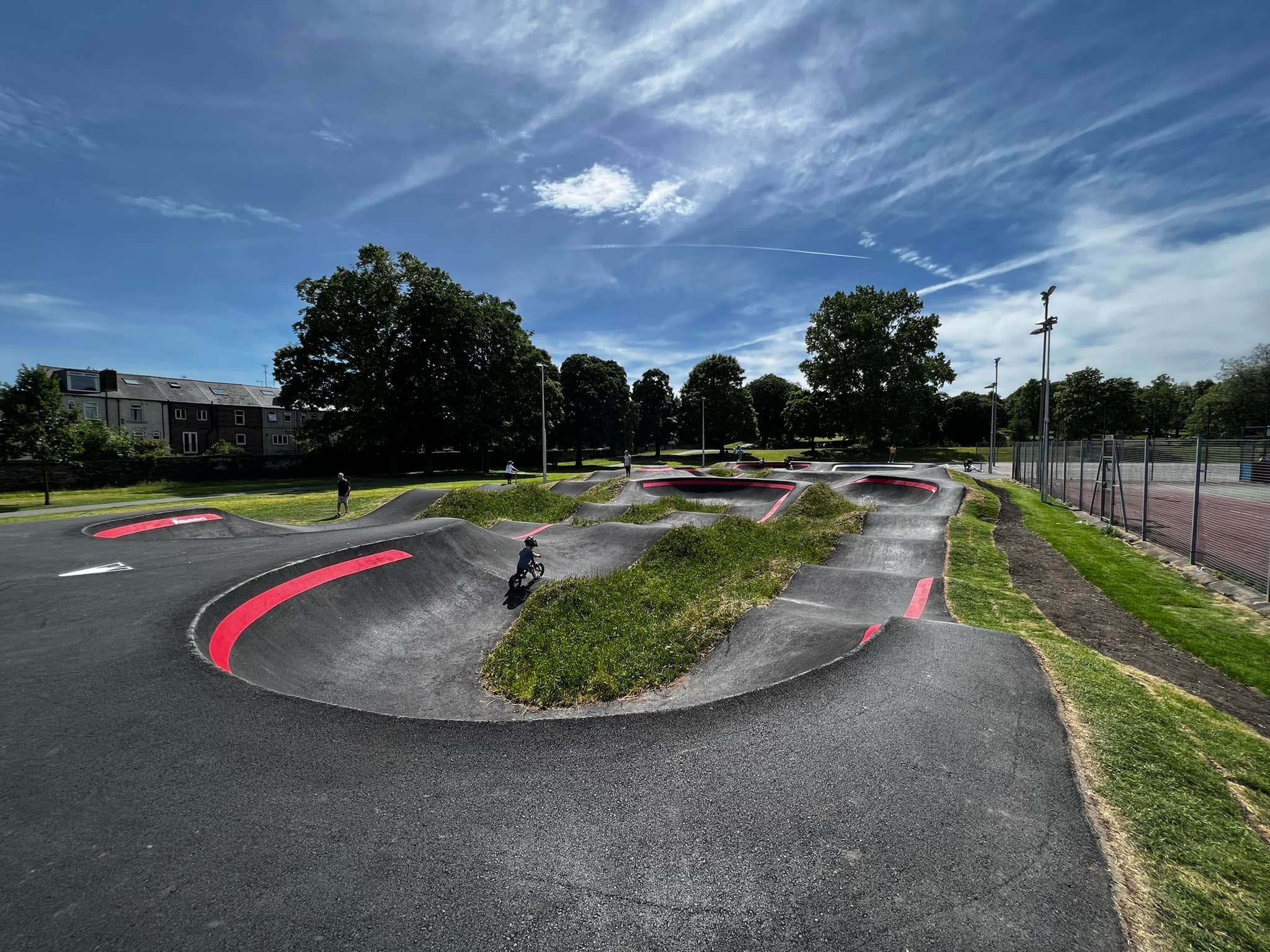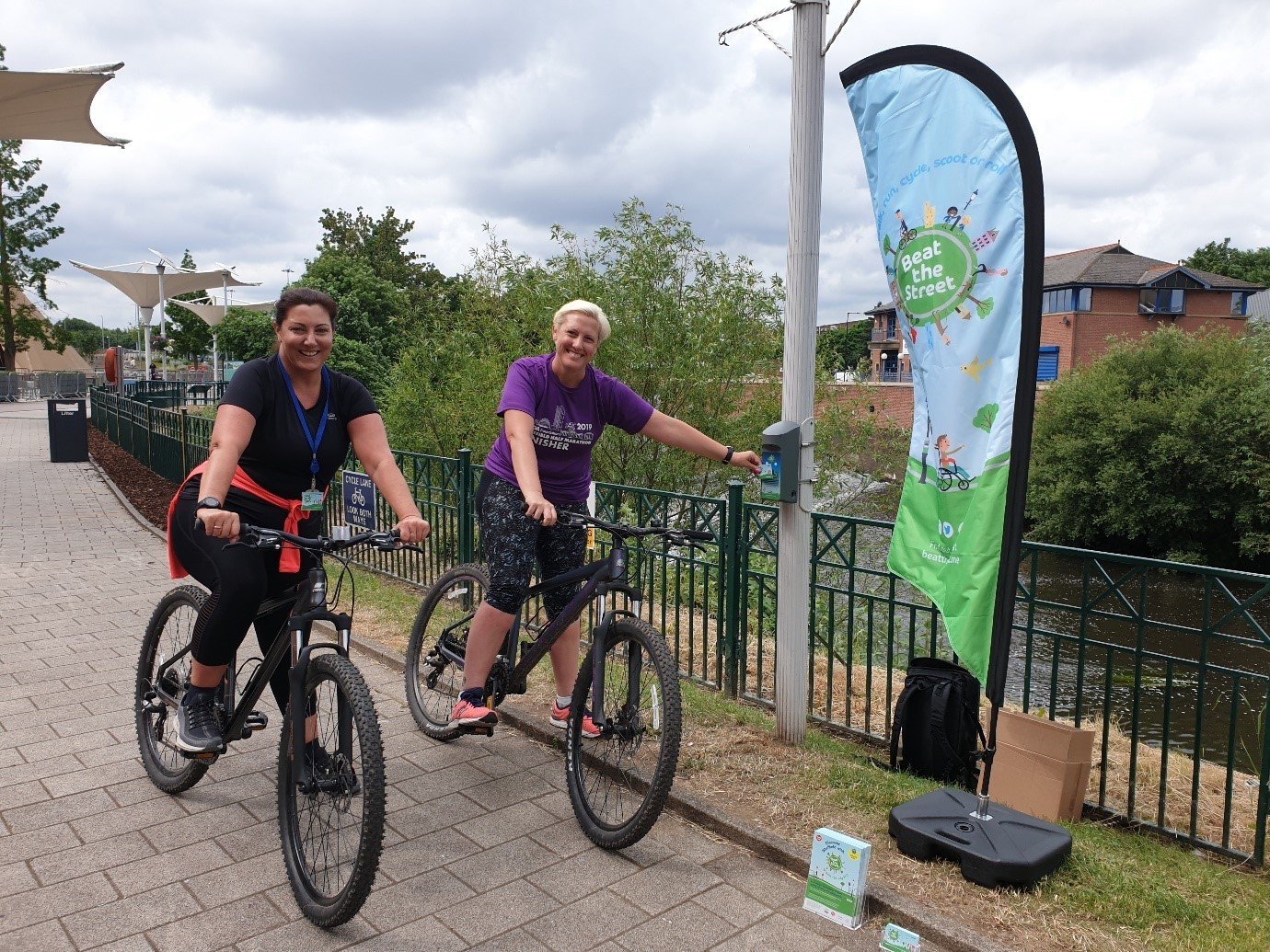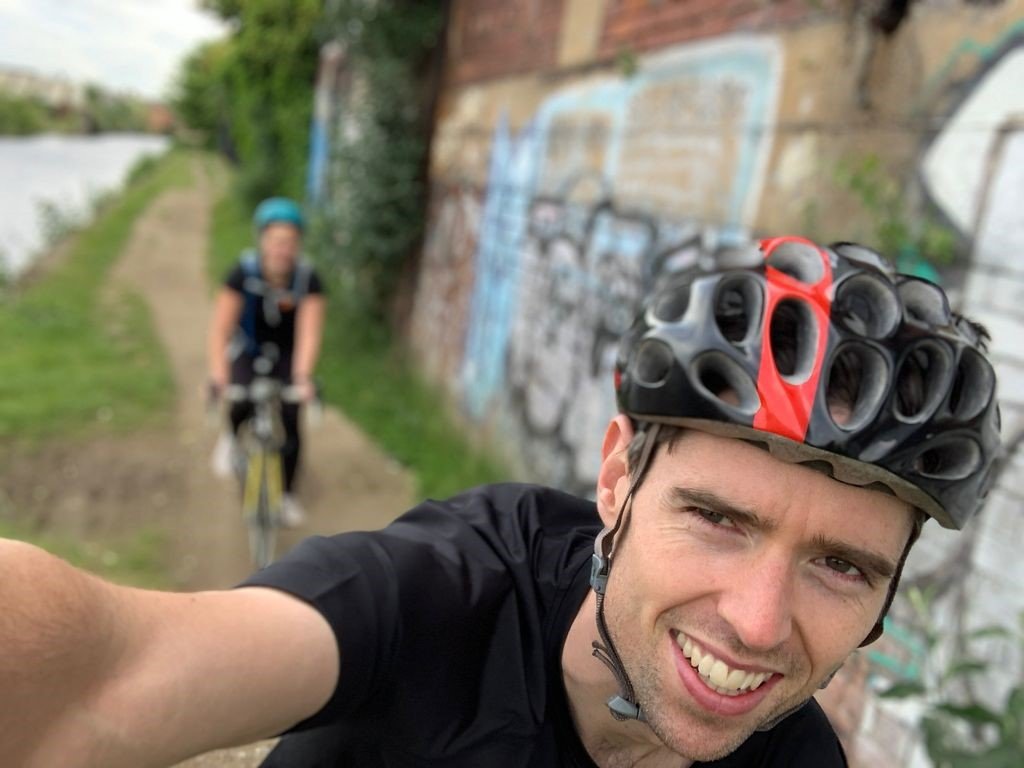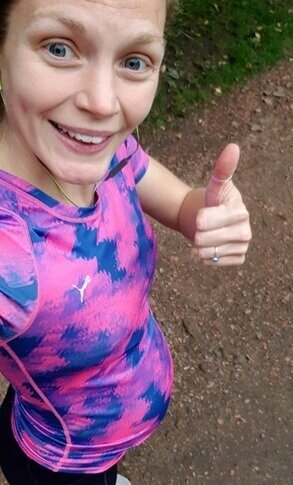
BLOG
Sheffield Make the Move day
They say Sheffield is built on 7 hills, or is it built on 7 parkruns?
On 9th July Move More Sheffield collaborated with parkrun for the first time creating a city wide event, celebrating the fantastic work done across the city by health and social care teams.
With health care professionals from across the city taking part in various different ways, from running to volunteering or bringing their families down to enjoy the brilliant weekly community event that is parkrun.
We wanted to celebrate the contribution made- not just within the NHS, but also from our social prescribing partners. Collaboration and community have been at the heart of the pandemic response and physical activity continues to be of vital importance for people to recover and reconnect.
Recent research highlights that parks and open spaces as well as having a sense of belonging within their community, improve people’s wellbeing looking at these joyful pictures, it’s easy to see why!
Check out the parkrun page for information on where they take place in Sheffield and how to join!
Move More Month 2022
Olympic Legacy in Action
A look back on Move more month 2022.
Another June has passed and another whirlwind Move More Month complete!
Move More Month was set up to shine a spotlight for one month onto Sport and Physical Activity in Sheffield and over the last few years we have achieved some remarkable things, we have set a Guinness World Record, delivered the largest game of Beat The Street ever and lots in between.
For me and those people and organisations I work with it is about inspiring people and creating more opportunities for people to be active whatever that looks like and the reality is we want this to happen all year round.
This June was once again unique and it certainly isn’t without its challenges but we love nothing more than a challenge!
I was reflecting on Jen Parry (Communciation and Engagement Officer at AWRC) blog over the last couple of weeks and it has been an interesting journey these last 7 months and one that we wouldn’t have completed without lots of people getting involved – far too many to mention, but notable contributions from some Move More Heroes – hopefully you know who you are!
What can’t be forgotten and has been developed over the last decade and is integral to the work we do in Sheffield is the trusted relationships we have across multiple organisations.
One of those relationships is with Sheffield Olympic Legacy Park. For me it is an absolute jewel in the crown in Sheffield in terms of outdoor and indoor space in Sheffield, there is so much going on there and I was asked by Claire Fretwell in November 2021 to help celebrate that – we couldn’t really say no.
It’s hard to believe that it is nearly 10 years since the London 2012 Olympic and Paralympic games and what is levelled at lots of host cities and countries is ‘what is the legacy of the games?’
I may be biased but Sheffield is flying the flag on this front. Not only do we have Sheffield Olympic Legacy Park that continues to grow in size and stature it also resulted in the creation of the National Centre for Sport and Exercise Medicine (NCSEM) Sheffield and ultimately the development of the Move More, Sport and Physical Activity Strategy.
The Lord Mayor and Cllr Mazher Iqbal enjoying the Colour Smash
The highlight of Move More Month this year was what transpired over the weekend of 17 – 19 June – the Olympic Legacy in Action weekend!
This was the result of 100’s of conversations, and meetings as well as countless emails but what shone through most was the willingness and passion of both local and city wide organisations to put their hands up and say that they wanted get involved to give more people an opportunity to be active and celebrate great things that are happening in the City.
Once again, you hopefully know who you are and a massive thank you! I said from day one of meeting each of you, it doesn’t happen without you and it really wouldn’t have!
What is also important is that Move More Month isn’t about a select few organisations, we want Sheffield to own it and be part of it in anyway that you see fit.
This year we had SOAR Community hosting their own Health and Wellbeing event connecting and engaging with their local community.
We had Diabetes Sheffield putting on a Move More with Diabetes conference to support people with Diabetes to get and remain active!
And other organisations who just live and breathe physical activity and work tirelessly throughout the year to get their community active like Shipshape and Darnall Wellbeing among countless others.
We can’t wait to see what you and others get up to in June 2023!
What happened on the Olympic Legacy Weekender
On Friday 17 June we welcomed over 1,000 school pupils from across the city to take part in a number of activities at Sheffield Olympic Legacy Park.
The undoubted highlight of which was the Colour Smash! For those who don’t know what a colour smash is – just check out the pictures!
But thank you to Sheffield Eagles and Andrea Dobson for hosting the city Tag Rugby League Finals, Dawn Wood for hosting an Inclusive Cricket Tournament and Andy Staley hosting 160 Year 9 girls at a This Girl Can event across the EISS and iceSheffield across the day!
Organised chaos at its best!
On Saturday 18 June, 31 different organisations came down to Sheffield Olympic Legacy Park and opened up their activities for people to join in.
We had everything from Paddleboarding and Kayaking, Cycling, Netball, Dance and more.
What was also a brilliant part of the day was the ability to bring what happens behind the doors at the Advanced Wellbeing Research Centre (AWRC) and bring that to life for those in attendance.
Thanks to the AWRC for hosting their heptathlon event, it really did bring a completely different flavour to the day!
As with any first event like this, we have learned plenty and it’s a watch this space ahead of 2023!
Lastly, on the Sunday with thanks to Leisure United, Sheffield and Hallamshire County FA and Dawn Wood we were able to run a brilliant inclusive football festival that had dedicated sessions for those with visual impairments and cerebral palsy and was followed by a fantastic football festival.
A perfect way to round off a brilliant weekend!
Thank you to everyone involved, we will take some time to recover, reflect and look ahead to what may happen in Move More Month 2023 – feel free to start your planning now!
For more information get in touch with tom.hughes@yorkshiresport.org
Hillsborough Pump Track
The Hillsborough Pump Track is a new cycling facility in the heart of one of Sheffield's city parks.
This blog post from Dr Gareth Jones takes you through His journey of taking a pipe dream through to reality.
I am an exercise psychologist at Sheffield Hallam University with a specific interest in children and young people's (CYP) physical and mental health. The mode in which I aim to positively impact this is through encouraging the promotion and adoption of physical activity. It is worth noting that I am a keen cyclist - mountain bike enthusiast, skate park goer and regular road user (mainly for commuting). In all my years of riding skate parks and pump tracks however, one of my observations had been how eclectic the user groups were; all shapes, sizes, ages, genders, and backgrounds, all coming together for a common purpose - to have fun! Being active was a by-product of that fun.
Children and Young People are a research focus of mine as I believe that early intervention is key. The earlier we can support CYP to have positive experiences and build healthy connections/habits with living a physically active life, the better chance we have of impacting population level health. Research demonstrates that behaviours adopted in early life are relatively consistent across the life span... such, if someone enjoys, and is active in their formative years, they are more likely to carry that on in some shape or form as they journey through life... the same can be said the other way round.
We also know that the physical environment in which we live and grow up in can have a strong impact on our health behaviours. If we grow up in an environment that is not conducive to living an active life, then it will be much more difficult to do so. Bringing this back to cycling, I noticed that Sheffield was lacking in high quality urban cycling facilities (e.g. skateparks, pump tracks, bmx tracks), although there are a couple existing facilities to note, such as Onboard skatepark, Bolehills BMX track and for local nostalgic reasons, Dev Green, but Sheffield is a big city and the balance felt off.
These types of facilities offer a different opportunity to get active outside of traditional mainstream sports, where kids can build resilience, self-esteem, friendships and perseverance. I wanted to help change that, with the knowledge that if we could build more high quality, inclusive, outdoor facilities in Sheffield, it would go a long way to supporting the next generation to be able to live active lives and reap the physical and mental health benefits too. In addition, focusing on a facility that promoted cycling skills would also benefit later years, as participating in these types of facilities will improve confidence on two wheels in general, making cycling a more viable option as part of active living later in life.
My vision was, therefore, clear in my head. To develop a programme that brought a new cycling facility to Sheffield to enthuse and enable children and young people to live more physically active lives, helping improve their physical and mental health.
I contacted various companies and charities to see how I could get this idea off the ground. I came across Access Sport, which were a perfect fit with this vision. Their mission is to improve the health and wellbeing of children and young people and inclusion groups using sport, with one of their most successful programmes being cycling.
I also reached out to Sheffield City Council (SCC) and other important stakeholders. Specifically, Luke Wilson, Jon Dallow, Paul Sullivan, and Jo Pearce of Sheffield City Council. There were more, but these guys and girls really stoked the fire throughout.
As a group, we collectively created the idea and explored how we could get a programme going, creating a route map from where we were to where we wanted to be; creating a new facility in the city.
I am also a member of the Move More Coordination group, and so gaining the opinions and professional support of the people we needed to bring the concept to fruition, was relatively simple. This is one of the many benefits of Move More Sheffield, as the communication across sectors and organisations is much improved.
Partnering with SCC and Access Sport the concept was born. Hillsborough Park was selected as the park of choice and we began the process of conducting a rigorous community consultation process where we (myself, SCC, Access Sport, British Cycling) discussed various cycling ideas with the public. The community's input was integral in the design of the programme and the finer details. This was a reiterative process over many months, which was a significant reason for the success of the current facility.
The next period of time included securing funds. Access Sport, SCC and British Cycling all contributed to ensure the original vision of a high-quality facility was realised. We then had to go about putting a planning application to SCC together, putting the opportunity out to tender, awarding the contract and getting the build started... all during a global pandemic! I really have to thank SCC and Access Sport here, as they did all the heavy lifting during these process!
Although this project started with my vision (which continues... this is only step one!), this would not have gone anywhere without the shared vision of others within the city. Sheffield is quite fortunate here as it has many like-minded folk, who love the outdoors and know how to get stuff done!
I view this project as a tangible success, partly for myself in what I set out about to achieve, but more of a success of Move More. Without Move More and Sheffield adopting the whole systems approach mentality, I think this would still be a pipe dream in my head. The whole systems approach connects people, aligns visions, and focuses attention.
Where are we up to now?
In track was finished and signed off on Wednesday 8th June 2022.
Every evening the track is bustling with life which is great to see. We are now in the process of establishing a thriving community club, the local community can engage with and utilise to develop their cycling skills, as well as connecting with local businesses such as Tony Butterworth Cycles to widen the local community benefit. We are also in early talks of starting this process all over again elsewhere in the city! Super excited and grateful to be able to support Sheffield in such a tangible way! Something we, as researchers, are not always able to do so in such an obvious way.
The Hillsborough Pump Track includes:
A fully tarmacked pump track, including a learn to ride area, an early riders track and a main track.
Floodlights to keep riders going through the winter months
A storage container with bikes and helmets etc.
Coaching equipment
To follow what is happening at the pump track, please follow @HillsboroughPumpTrack on Facebook or @Hillsboroughbmxclub on Instagram.
Thanks for taking the time to read my ramblings during this blog post, and if you do get the chance to come down to the track, please do! We have bikes you can use if you don't have one! 🙂
With special thanks to those who made it happen.
Sarah Storey - Active Travel Commissioner
Dame Sarah Storey has recently left her post as Active Travel Commissioner for Sheffield City Region.
Here she reflects on her time in post, the work she was involved in and the role that Active Travel needs to play going forward.
Having recently left working in South Yorkshire for my home city of Manchester, I’ve spent many a happy hour pedalling my bike and reflecting on the 3 years spent steering the Active Travel Programme during Dan Jarvis’ mayoral term.
When I first arrived in Sheffield for the announcement of my appointment, I was overwhelmed by the excitement and welcome from the people, many of whom I went on to work alongside throughout my post. With a rich history of being the outdoor city, a vital piece of that culture was missing, in that it was [and sadly still is] incredibly difficult to get around without a motor vehicle. I pledged I would be guided and hold the region to account on 4 key pillars;
We would be led by our communities
We would enable and not just encourage
All infrastructure would meet or exceed new standards
We would ensure all infrastructure was accessible everyone regardless of their access needs
From the start, road danger reduction was a key focus of every community I visited. It would take time to build new active travel infrastructure, reallocate road space and change people’s mindset that a car didn’t need to always be the default mode of travel, so it was vital we tackled the poor behaviour of a minority of drivers that dominated the reasons why people didn’t feel safe enough to walk or cycle already.
Early engagement with South Yorkshire Police provided us with a single point of contact in Inspector Kevin Smith and together we discussed the strategy that would disseminate best practise for roads policing to better protect those out walking or cycling.
Inspector Smith launched the Operation Close Pass campaign and I joined him on this for a very eye opening afternoon of cycling on a road that I had to admit I would always avoid due to the dangers we faced. Further expansion of roads traffic policing is in the pipeline and Inspector Smith has a very open dialogue within his neighbourhood and is sharing this best practice across South Yorkshire Police.
Another key area of our preparations for when the region has a more comprehensive network, was to widen access to a cycles for a wider variety of needs. Sheffield already had a well established Cycling for All hub and we worked with Cycling Projects to establish hubs like this in the other parts of the region – Doncaster and Barnsley have opened this year.
These have enabled individuals and groups who have never tried cycling before, and are opening specialist social prescribing opportunities and widened the discussion around what cycling actually can achieve. Although there are still those who assume a person with a disability or long term health condition will never cycle, the narrative about cycling is changing and more people are seeing it as an activity or transport solution, not just as a sport.
In some medical practices active travel is seen as a solution to physical and mental health challenges, and we have started to make greater links with the Integrated Care System so that the dial can be shifted to create longer healthy lives through being active. A new Social prescribing pilot has started in Doncaster, building on their local delivery pilot, and learning from the great work across Yorkshire, including practices in Sheffield. I also helped convince Mayor Dan Jarvis to allocate £1m towards better walking and wheeling access for local nature spots, a key lesson from the pandemic.
During the first year of the programme the new infrastructure standards were adopted by the leaders of the region and this has really helped shape the narrative of how we provide active travel lanes and convenient walking routes that people will use.
More and more it is being understood that the inconvenience and journey delays should be distributed across all modes, with those travelling on foot or bike taking the most direct route. To further expand on the priority of those walking and cycling, local authorities are developing Active Neighbourhood plans which install modal filters to ensure vehicle traffic is longer able to use a residential area as a through route and reduces vehicle dependence for short journeys.
Pre-pandemic, 40% of utility journeys that were a kilometre or less were being driven and whilst a new normal hasn’t had time to stabilise it is my hope that the health lessons learned through what has been a dreadful two years, will see more awareness of the importance of building activity in to everyone’s day.
Travelling on foot or bike for short journeys remains the most effective and best use of everyone’s time and at a time when household budgets are squeezed and people and struggling to make ends meet, there should be no question that it is easy to access goods, services and opportunity in life, without the pre-requisite of owning a car.
Whilst I walk and cycle to work on the other side of the hill now, I am very keen to support the next phase for active travel in South Yorkshire and look forward to returning soon.
Move More Active Practice
Thanks to David Bocking for creating and publishing this story.
“Inactivity is a feature in almost every long term health condition we deal with, “ says Dr Ollie Hart.
Ollie and many other Sheffield doctors have been banging on about this for years, and setting an example by cycling and running all the time and generally breezing into their surgeries looking like athletes.
Ollie himself didn’t manage to run the Sheffield Half Marathon earlier this month because he was pounding round the 21.1 mile 1500 yard ascent Edale Skyline fell race instead. Which is not necessarily everybody’s cup of tea, he accepts “The way you promote exercise matters,” he says. “It doesn’t work by just wagging your finger at someone and saying; ‘You should do something!’”
This week, 10 Sheffield GP centres will receive the launch pack of the city’s Move More Active Practice network, conveyed to their doors by the Russell’s Bicycle Shed e-cargo bike delivery service.
“We have some brilliant local advocates for leading active lifestyles in the health area already, and we want to grow that influence, because we know the value that health practitioners can have on the communities they see and support,” said Tom Hughes of scheme partners Yorkshire Sport.
“We also know that we are facing a climate emergency and the role that travelling short journeys in vehicles can contribute to this, so using the e-cargo bike from Russell’s is a brilliant way of delivering materials to our surgeries and setting an example for others to follow.”
The idea of the Active Practice network, says Move More GP Jo Maher, is twofold.
“We want to reemphasise the importance of physical activity and exercise in keeping people physically and mentally well,” she says, “and also signpost people to all the many free resources we have in Sheffield that anybody can use.”
Jo cites work already started by Active Practices in the Shirebrook Valley Nature Reserve with the local Health Walks programme and Sheffield and Rotherham Wildlife Trust, links between her own surgery in Wincobank and the Ingle Runners group and the SOAR community regeneration charity, a digital resource set up by Kira Watson at the Porter Valley primary care network detailing local physical health and wellbeing activities, and the ‘health coaching’ initiative used in Heeley by Ollie Hart and his colleagues.
“We talk to people about what matters to them, what’s most likely to attain a life they value,” says Ollie. “They might say they want to have more energy to keep up with the kids, to concentrate better at work, to sleep well or to have good relationships. And being physically fit makes a difference to all of that, along with things people know about like cancer, inflammation, mental health and cardiovascular health.”
He adds: “Everyone knows that physically activity is good for you, the question is, how are you going to prioritise it in the hectic craziness of your life?”
So the next step is to help that particular person find their equivalent of Ollie’s Edale Skyline race, which could be a walking or gardening group, a nearby social group or the local parkrun. 10 years ago, very much ahead of the game, Ollie’s surgery, Sloan at Heeley, set up the Graves parkrun and began promoting the weekly 5k run or walk to staff and patients. More recently the national parkrun organisation is now promoting links between GP centres and local parkruns, with around 15% of UK GP centres now ‘parkrun practices’ (in Sheffield it’s 35%).
(The Graves run celebrated its 10 year link with local primary health care on April 9th)
Jo Maher hopes all local GP centres can find a way to become Active Practices, choosing programmes to suit them, their staff and their patients, and she’s delighted the NHS is now actively supporting the idea of exercise ‘on prescription.’ Not least because a healthier and happier population will reduce the workload of NHS staff, she says.
“We’d love to reduce people’s reliance on health professionals. I think it makes people feel more in control of things.”
For more info: https://www.movemoresheffield.com/move-more-active-practice
Step Out Sheffield
Step Out Sheffield’s short led weekly walks can help establish a regular exercise habit and improve socialisation and wellbeing
Step Out Sheffield is a volunteer-led organisation, founded in 2016 that provides short walks at 23 different venues across the city each week. Our experienced Volunteer Walk Leaders have all been trained, and are insured, by our umbrella organisation, the Ramblers.
Walks generally last between 40 minutes and an hour and are delivered at a pace to suit our walkers. To accommodate all levels of fitness our volunteers offer a choice of walks: a shorter, slower walk and a longer, brisker one. With one or two exceptions the leaders vary the route from week to week to introduce variety and to take account of the ground conditions and the weather.
Walking in a group with experienced Volunteer leaders enables walkers to confidently walk in open spaces and woodlands. An Ecclesall Woods walker says she would ‘never enter the woods alone, but feels safe in a group and knows that the Volunteers won’t get her lost or leave her should she trip and fall’.
Walking regularly with a group can improve commitment! A Bramall Lane walker said his weekly walk ‘gives him a purpose to get up in the morning and get out for some fresh air’
We all know that walking at a pace that is comfortable for you is good for your physical health. But walking in nature can also provide an emotional lift and reduce your stress levels. And that applies whatever the weather. An important Step Out Sheffield aim is the provision of the chance to socialise both during and after the walk. We find that walkers have forgotten about the weather by the time they are half-way down their cuppa and enjoying a chat with their walking pals! Many of our walkers have said they value their walk because it helps reduce social isolation and loneliness. A Totley walker remarked that ‘the walk is the only time in the week I get to speak to anyone’. A Pitsmoor walker also said his walk is ‘the only point in the week when he knows he will be able to meet and talk with people he is familiar with’.
Regular walking has many health benefits. It can help people rehabilitate after surgery and walkers at Pitsmoor, Hackenthorpe, and Porter Valley all reported ‘how helpful their regular walks had been after they’d had a stroke’. A Stannington walker said walking had ‘helped her lose weight’, a Pitsmoor walker said his walk ‘helped to reduce depression’. And a Hackenthorpe walker said that since she started walking regularly, she’d experienced a ‘reduction in chest infections….and felt less out of breath and her fitness has improved greatly’. Walkers as far apart as Dore and Pitsmoor said how much their walks had helped them ‘settle into the community’ when they moved to Sheffield. A Graves Park walker said how ‘the solace she found on the walks, and additional activities with fiends she’d made on the walks, had helped her move forward after her husband died’. A Stannington walker said the walks were a good way of keeping busy post retirement. Volunteers reported benefits too including: ‘being able to help others in the community’, ‘enjoying the company of walkers and other Volunteers’ and ‘the walk I Volunteer with provides me with a sense of purpose’.
Step Out Sheffield walks are free – all that’s needed is a comfortable pair of supportive and ideally waterproof shoes. To join a walk simply turn up at the start point ten minutes before the scheduled start time and introduce yourself to a Volunteer – they’ll be wearing a hi-viz jacket.
For further information on any of our walks phone our Help Line 075 0563 9524 or visit our web page on the Ramblers Walking for Health website (www.walkingforhealth.org.uk) or visit the Step Out Sheffield website www.stepoutsheffield.co.uk
Grenoside walkers enjoying the sunshine in Wheata Woods, December 2021
Before Step Out Sheffield took over the administration and delivery of health walks in Sheffield, these walks were delivered in the same format and in many cases by the very same Volunteers, under the watchful eye of SCC Project Rangers and, for a brief time, by Activity Sheffield. The first Sheffield Health Walk was launched from Buchanan Road Surgery in May 1999. Over the ensuing years additional walks were added until a city-wide programme of walks was established utilising many of Sheffield’s fabulous parks, woodlands, and green spaces. Step Out Sheffield is proud to be the biggest volunteer-led Ramblers Wellbeing Walks scheme. Sheffield’s Health Walk scheme has been running continuously now for almost 23 years making it the longest continuously running Health Walks scheme in the country.
The quotes were collected and collated by medical students Zahra Ahmed, Harriet Beattie, Gwen Craddock and Luke Jones. They visited some of our walks as part of their Community Engagement placement with Step out Sheffield in November and December 2021. They also produced a short YouTube film to promote our walks: https://www.youtube.com/watch?v=srb-Yp4PgsY
Sue Lee
Sue has been involved with Sheffield’s health walks since 2003 when she was engaged by Sheffield City Council as a Project Ranger to develop and deliver walks in Southwest Sheffield. When she retired in 2012, she continued to support the walks as a Volunteer Walk Leader and, in 2016, became the volunteer Chair of Step Out Sheffield, a full-time role.
Beat the Street - The Impact on Sheffield
Beat The Street Sheffield set out to increase physical activity levels in both adults and children, with a particular focus on addressing health inequalities. The response to the game from the city was overwhelmingly positive.
You may remember that when you registered for the game that there were some questions as part of the registration process, well this was to help the City understand the impact that the game had on Sheffield. Intelligent Health who delivered the game have spent some time crunching the numbers and we are keen to present the selected findings from the data we collected during and after the Beat Boxes visited Sheffield!
Beat the Street in Sheffield was the largest ever Beat the Street programme. Over 11% of the population (of c. 518,000) took part during the six-week game phase between 16 June and 28 July. 60,187 participants walked, jogged, ran, cycled, scooted and rolled a total of 452,870 miles between them.
Registration data was collected on 44,765 people, including 28,201 children at the start of the game, providing audience insight into who was taking part; their age, gender, ethnicity and from which areas of the city they lived. A further 32,149 people completed an additional (optional) survey on their physical activity levels, long-term conditions, disability and mental wellbeing. All this data helps us to understand whether the game was a success and had the desired impact of getting Sheffield to move more!
By comparing the registration data to local data, we can conclude that Beat the Street was able to reach people from each part of the city, young and old, active and inactive and those under-represented communities who are more likely to experience health inequalities.
Following the game phase, participants were invited to complete the health survey again, along with some additional questions which will allow us to measure the behaviour change and impact that Beat the Street has had on individuals.
Matched data was collected on 1,937 adults and 1,843 children. This data showed that of the adults (n=1,937) and children (n=1,843) who were inactive at the start of the game, 70% and 67% had become active when surveyed at the end of the game. People also reported increased feelings of life satisfaction and worthwhileness and lower levels of anxiety.
Mapping Participation
Over the 6-week game phase, our players actively travelled 7.5 miles per player on average.
The image below shows the levels of participation in the different parts of Sheffield where the Beat Boxes were located. Areas in red highlight the most participation (taps on Beat Boxes) and areas in blue highlight lower participation. There was strong engagement with Beat Boxes across Sheffield.
Following the game, 63% of players stated that Beat the Street encouraged them to explore new areas and 62% said it helped them feel like part of their community (based on 4,619 respondents).
Follow the QR code below to see the movement generated throughout Sheffield over just 24 hours of the game.
There was a clear spike in participation during morning and afternoon commute times. 35% of all activity undertaken was between 8–9am and 3–4pm which are typical commute periods.
Who took part?
Gender
57% of players who registered to take part were female, whereas 41% were male. A further 0.2% identified as non-binary and 2% preferred not to disclose their gender.
Age
63% of players who registered to take part were aged 18 or under. Another significant proportion of participants were aged between 30–49, likely to be the parents/carers of the schoolchildren. A further 4% were aged between 19–29 and 6% were aged 50+.
Participants with long term health conditions
15% of players who registered to take part in Beat the Street self-reported as having a long-term medical condition. 1% had diabetes, 0.4% had heart disease, 0.2% had COPD (emphysema), 7% had asthma, 2% had a mental health condition and 4% reported having another kind of long-term medical condition. 3% of players preferred not to answer this question.
Ethnicity
9% of players who registered to take part identified as being of Black, Asian and other culturally diverse backgrounds. 78% identified as being of white ethnic background and 3% preferred not to answer this question.
(Dis)ability
4% of players who registered to take part before the game self-reported as having a disability. 93% reported not having a disability whereas 3% preferred not to answer this question.
Socio Economic Group
37% of players who registered to take part were living in Index of Multiple Deprivation groups 1 and 2, which are defined as high by the government in England. 11% were living in in Index of Multiple Deprivation groups 3 and 4, which are defined as mid-high. 16% were living in Index of Multiple Deprivation groups 5 and 6, which are defined as mid. 15% were living in Index of Multiple Deprivation groups 7 and 8, which are defined as mid-low. 22% were living in Index of Multiple Deprivation groups 9 and 10, which are defined as low.
Inactivity
17% and 16% of adults and children who registered to take part were inactive before the game. For those living in areas of higher deprivation, inactivity levels were higher at registration.
Behaviour Change
Following Beat the Street, 67% of children who were inactive before the game, had become active (based on 1,843 matched pairs). This was consistently high for those living in areas of higher deprivation.
Active Travel
Most players felt they had travelled more actively during Beat the Street. 66% felt they had walked more, 8% felt they had cycled more, and 2% had wheeled more (based on 4,625 respondents).
Mental Wellbeing
Following Beat the Street, the wellbeing of residents improved. High or very high feelings of life satisfaction and worthwhileness both increased by 6%. Additionally, the proportion of adults reporting very low levels of anxiety increased by 7% and the proportion reporting high or very high levels of happiness remained the same (based on 1,977 matched pairs.
Conclusion
Beat the Street Sheffield set out to increase physical activity levels, improve health and wellbeing amongst its residents and encourage active travel. Over the 6-week game phase, 60,187 people walked, cycled, wheeled and scooted 452,964 miles. Following Beat the Street, 70% of adults and 67% of children were lifted out of inactivity. The game encouraged people to use active modes of travel to get to school and work, with Beat Box data showing 36% of all activity undertaken was between 8–9am and 3–4pm. 76% of players felt they had walked, cycled or wheeled more for travel as a result of Beat the Street. The game has led to significant improvements to the mental wellbeing of Sheffield residents.
Beat the Street wouldn’t have been such a success without the backing of a large cast of partners and supporters. Sheffield has created in its innovate whole system approach represented by Move More a network of partners in green spaces, sports and exercise, health and social care, and culture and communities. Our events with community partners, British Cycling, Meadowhall, the Olympic Legacy Park and Sheffield Eagles, the Canal and River Trust, Sheffield Adventure Film Festival and Cliffhanger, the Bears of Sheffield and Create Sheffield, the Peak District National Park and SCC’s Parks and Countryside Service, were amazing collaborative events and opportunities that showed off the very best of Sheffield.
Our Engagement Coordinator team has continued to work with the partners, schools and communities they have established relationships with to support the Sheffield’s population to stay active.
Alasdair, Natalie and Daniel have all been instrumental in the legacy phase of the programme, working on a range of projects to ensure the sustainability of Beat the Street and the behaviour change that they helped to create. Key elements of this sustainability drive are: helping to roll out Play Streets across the city; creating opportunities for schools to become more engaged with the Peak District National Park through outdoor education opportunities for teachers and staff; linking schools to active travel and physical activity opportunities; Walk Leader training for community leaders; publicising local sport and exercise groups and green spaces; and continuing to signpost to opportunities for our players on social media and in our newsletter.
We also look forward to receiving and analysing the data from the 6- and 12-month surveys. Our qualitative data shows just how much Sheffield enjoyed Beat the Street, and the data presented here shows the effects the game continues to have on the city.
Going Green- Healthy Humans, Healthy Planet
Written by Andy Douglas - Sheffield GP
As COP26 draws to a close, Andy Douglas reflects on what this means for him, his profession and Sheffield.
‘Cycle to work’ he said, ‘it’ll be fun’ he said.
In my enthusiasm to spread the joy of cycling to work, I have certainly forgotten on a couple of occasions what it is like to cycle in Sheffield city streets as a novice. It’s scary and dangerous and I always feel bad when it becomes clear that I shouldn’t have suggested a novice cyclist throw themselves in at the deep-end, and take on the gauntlet of queens road, for example. Tram tracks, close passes, abuse, noise, fumes, getting pushed off your bike, can it get much worse? Unfortunately there isn’t a shallow-end option.
It’s why the work that Move More does is so important: it’s not just telling people to be more active, it’s trying to adapt the environment and conditions that we live our lives in to make being active the obvious choice. Move More may come across as some kind of physical activity provider or referral system, but in reality is anyone in Sheffield who wants to promote or prioritise ways to be physically active in our city.
At the moment choosing to be active in Sheffield is hard work, not open to everyone, and sometimes dangerous.
With a warming planet, air pollution, inactivity epidemic, mental health crisis, and pending mass extinction of species it seems to me we cannot keep using fossil fuel powered transport. The covid pandemic is bad but comparable in terms of deaths to air pollution in the UK, which kills approximately 100,000 people per year.
I liked Attenborough’s ‘A Life on Our Planet’, because rather then the usual doom and gloom it provided some hope of a solution. This was of the possibility of a stabilisation in global population meaning we could use, conserve and recycle our resources sustainably in order to see a future for humans on earth.
There are often glimmers of hope for human and climate friendly travel options in Sheffield. It feels like Sheffielders are up for it: we’re known as the outdoor city, we have world class outdoors sports, we are proud of our seven hills, we have a ‘you’ll be reyt attitude’ to most things! The new cycling and walking routes through our city are brilliant and the grey to green stuff is inspiring. Our parks, green spaces and the connections between them, as beautifully illustrated in the Green-ground maps, are some of the best in Europe.
In Sheffield healthcare we are lucky to have ‘Greener Practice’ paving the way on sustainability issues within the NHS. I only recently learned from them that the first rule of making healthcare more green is prevention. Prevention of disease and illness means less medicines, less tests, less transport, less facilities, less packaging, and less money. It’s well known in public health that money spent on physical activity is the most cost effective solution in terms of prevention of disease.
It’s only fairly recently we have discovered quite how bad not being active is for our health. Inactivity contributes to 1 in 6 of all deaths in the UK.
To me, deciding whether to be active in cities like ours isn’t even an option- everyone needs to do it. We can’t continue being inactive, producing emissions, and using resources. We need to embrace active travel, not as a horrible substitute, but instead we need to create the conditions that allow it to be a desirable choice that is enjoyable, sociable, and fun. Like Move More say, we need to create the conditions in our city for a healthier, happier and more connected Sheffield.
Hopefully in five years time we’ll all be able to recommend cycling or walking around Sheffield, without the risk and worry of running the gauntlet each time we step out the front door
Parkwood Springs Lantern Festival
Parkwood Springs is described as a country paRk in the city offering an array of amazing, natural, wild space on the edge of the city centre.
The park overlooks the centre of Sheffield and is more well known as the site of the old Ski Village. But for those who have ever visited will know that it offers unobstructed views across the city as well as offering plenty of trails and routes to explore on foot or on a bike and you can meander between Kelham Island and head along to Wardsend Cemetery and Herries Road to Shirecliffe.
Neil Schofield of Friends of Parkwood Springs goes on to say that “It’s remarkable that in inner city Sheffield we’ve got this big area of green space as big as Hyde Park in London, with fantastic views and countryside that you could expect to see in the middle of the Peak District”
The Friends of Parkwood Springs have been working hard to raise the awareness of the site with support from the Parks and Countryside team at Sheffield City Council.
One way in which they have done this that since 2007 is that they have hosted an annual lantern festival within the park. The event is aimed at encouraging people in the community to come out of their homes and celebrate with their families and make use and raise awareness of this spectacular inner city greenspace.
This years event took place on Saturday October 16 and included Lantern-making, circus skills workshops, treasure hunts, live music and a fire juggler as night fell. The event saw children from nearby schools, Scout and Guide groups and people from churches and community groups carry their home made paper lanterns up to the hilltop from the playing fields off Cooks Wood Road.
The event saw over 380 people carrying animal lanterns joined by the Sheffield Samba Band to wander noisily up through the wooded slopes to the hilltop above Sheffield.
Jon Dallow, Woodlands Manager at Sheffield City Council describes the annual event as ‘a magical evening, with a cracking view and a safe warm community glow’
The park still faces challenges to attract people to the site, with people having no idea where it is, however due to the hard work of the Friends of Group and stakeholders in the city the tide is slowly starting to change.
Earlier in the day the park attracted 1,000 visitors to the school cross country event and there is a constant stream of dog walkers, football players and teams having a kickabout and mountain bikers making use of the routes and trails running between the trees.
It is far from a hidden gem with its position overlooking the city, but one that is well worth exploring.
For more information on the park and upcoming events head over to www.parkwood-springs.org.uk or to visit and explore for yourself, you can find parking off Cooks Wood Road (postcode - S3 9AA)
Moving more with a baby on board: My pregnancy running journey
By Helen Quirk
Helen is a runner and researcher in physical activity at the University of Sheffield. She has been a Move More advocate since starting her research career at Sheffield Hallam University in 2016. Helen was involved in the writing of the new Move More Strategy and here she talks about running whilst pregnant.
First things first, a bit of a disclaimer: I’m incredibly lucky to have had a smooth and complication-free pregnancy and I was a very active, regular runner before pregnancy. This is just my experience, but one I’m really happy to share with you.
I’ve been a runner for as long as I can remember, so it was natural for me to want to carry on running when I found out I was pregnant in February 2021. I was fortunate not to suffer with sickness in the first trimester. The tiredness and nausea weren’t a barrel of laughs, but I felt at my best when moving. So I just kept moving…
Me and my husband - enjoying the last of our freedom
I turned a corner at around 15 weeks and started to feel myself again - a bit of a honeymoon period of feeling pretty normal. Running had a different focus - miles, speed and time simply didn’t matter. It was actually pretty liberating not to care anymore. I’d have these weird (but wonderful) moments when I remembered I had a little baby on board to keep me company - just the beginning of many adventures we’ll have together. It was about this time that I did my last long run around Ladybower reservoir.
In June, Beat the Streets came to Sheffield, providing a much welcomed distraction and focus as my running and body changed. I threw myself into hunting down those beat boxes, finding new routes and earning points for TeamAWRCsome!
Beat boxing my way through my second trimester!
Beat the Streets was closely followed by the long-awaited return of parkrun in July. Armed with a genuine excuse for a slower post-lockdown pace, I did the first parkrun back, featuring a leafy new route at my local Endcliffe parkrun. I really hadn’t anticipated how amazing it would feel to run with other people again. The atmosphere was incredible - everyone was just so grateful to be back. I got swept away in the moment and forgot all about the heavy pregnancy legs (more about those later). Me looking pretty smitten to be back at parkrun.
Me looking pretty smitten to be back at parkrun.
Towards the end of the summer I was heading into the third trimester still feeling good and running regularly. I was also - ever the diligent student - doing my pelvic floor exercises, yoga and trying to get some strength work in there too.
At the end of September, our 5K Your Way group returned to Endcliffe parkrun. 5K Your Way is a support group for people affected by cancer.
We meet at Endcliffe parkrun on the last Saturday of every month, but we’d been on pause for 18 months due to the pandemic. It’s a simple concept - we meet at parkrun and walk, run, cheer or volunteer. We stick around afterwards for a cuppa and chat (cake optional). Everyone is welcome including friends, family and people working in cancer services. The more the merrier. Get in touch if you’d like more info - and please feel free to join us - we’ll be there on the last Saturday of every month for the foreseeable future!
5K Your Way Ambassadors Lorraine, me and Rebecca with our newest member of the 5K Your Way family, Emma. Photo courtesy of George Carman.
Has it reeeallly been that easy?
Ok, no - all this running hasn’t come without some downsides - so time to get real:
Getting slower - I’ve actually felt fine with this - lockdown (and the lack of any races/events) gave me a whole new appreciation for running that meant I couldn’t care less what the watch said.
Heavy legs - the legs have felt heavier than they did before, especially if I try to run on back-to-back days. A sure sign to ease-off or walk instead.
Hills- the hills!! Hills became instantly harder as soon as I became pregnant. Like a tonne of weight on my back whenever I hit any inclines, which are hard to avoid in Sheffield! I’m now more than happy to walk those hills, thank you very much.
Injury - I rolled my ankle quite badly whilst running at 32 weeks. A combination of getting a bit carried away at parkrun and hormones making my ligaments looser. A bit of a reality check that I’m not the nimble ninja I used to be and probably should reign it in a little.
Swollen feet - one I didn’t expect to be honest! My running shoes became really uncomfortable as my feet expanded. This pregnancy business really ain’t glamorous!
Bladder pressure - The fact that I feel the need to apologise before talking openly about this says it all really. It's a taboo subject, but feeling the need to wee more often is just the reality of increased pressure and a growing baby. I think we really need to normalise talking about this. Ladies, plan your routes near to home, public toilets or just embrace the occasional wild wee. For me, this was a small sacrifice for being able to carry on doing what I love.
So here I am, 35 weeks…
I've taken every day and run as it comes - at ease with the reality that each run could be the last for a while. Thankfully, I’ve had loads of positive support and haven’t experienced any negative comments or judgements. I feel most like me when I run. It’s my morning tonic, coping mechanism and happy place. To have been able to run throughout this weird and wonderful pregnancy journey is something I will be forever grateful for.
If you’d like more information about running during pregnancy - check out this parkrun Research Board seminar on running during pregnancy: https://youtu.be/MEdOOT1Pud8
Follow me on Twitter @hquirky
Email to find out more about 5K Your Way: endcliffegroup@5kyourway.org















